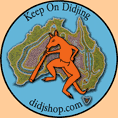| Didgeridoos and Aboriginality |
|
The following article is published here with the permission CMM15 - Feature Article The mellow drones of the didgeridoo, the solid rhythms of clap sticks, the visual delights that are dot-paintings: all of these images are becoming more identifiable, the world over, as symbols of the oldest culture on earth – the Australian indigenous culture. With this increased awareness of one of the world's most fascinating peoples, comes a heightened curiosity and desire to own a little piece of their culture. It is clear that the international awareness of the Australian indigenous culture is blossoming. This is reflected in the ever-expanding indigenous trade, which is estimated to be worth $200 million Australian dollars per year. In a recent survey conducted in Stockholm most people knew what a didgeridoo and a boomerang were, but were not so knowledgeable about the history of the indigenous culture. "We are one of the oldest living cultures in the world and there is a lot of truth which has been disregarded: hidden facts, stories of the past and present, and not forgetting the dreaming. What is old news to Australians still remains a mystery to the international eyes and ears. All are waiting for something new and unheard of from the land ‘downunder'," offers Gavin Alexa, an indigenous performer and artist. "I have been an Aboriginal and Torres Strait Islander (ATSI) performer and artist for over 11yrs now. My first opportunity was at the age of 16 when I began learning ATSI arts, crafts, themes, song, dance and recreation." Mr. Alexa believes there are frequencies of ethical ignorance and greed within the industry, and disrespect for artistic copyright laws, as well as neglect of intellectual property protocol. The popularity and exposure of Australian indigenous culture has presented indigenous and non-indigenous entrepreneurs with the opportunity to promote, or exploit the culture. Svargo Freitag, a German-born Australian, is the owner of an indigenous business in Kuranda, North Queensland. The Didgeridoo Specialist has been operating since 1992 and only purchases from Aboriginal suppliers and artists. He offers artists a generous purchasing price and follows this with an end of financial year bonus for all people involved in his venture. "We believe that we should sell only Aboriginal crafted artifacts and remunerate our suppliers fairly. We also see it as one of our responsibilities to raise Aboriginal issues," Mr Freitag comments, when asked about cultural responsibility. Mr. Freitag has observed some fraudulent activity in the retailing of authentic ATSI products. He enlightened us with an example of a Cairns based company selling their products to tourists as authentic Aboriginal items, and yet the products were made in Indonesia. How does The Didgeridoo Specialist guarantee its authenticity? "Only by our own integrity. Sadly, there is no reliable system to assure customers of the authenticity of an Aboriginal product. Some sellers of Aboriginal art issue authenticity certificates. We know these certificates to be issued for non-Aboriginal products (by unscrupulous operators). At one stage we were considering joining the ‘tick' authenticity label, but then we heard of the label being used on didges, which were painted by Aboriginal people, but cut and crafted by non-indigenous people. While we took this matter up with the authenticity organization, they went bankrupt..." The organization Svargo Freitag refers to is the National Indigenous Arts Advocacy Association (NIAAA). In late 1999, the NIAAA attempted to introduce an authentication label aimed at promoting genuine products and deterring fraud in the indigenous arts and crafts industry. By 2001, the protocol was decommissioned due to mismanagement and lack of funding. The industry is now void of official authenticity monitoring. "We believe the only reliable way to monitor authenticity is federal legislation requiring labeling of all Aboriginal artifacts, paintings (or any medium). The label should clearly state whether the product was produced and/or painted by an Aboriginal person or a non-Aboriginal person. ...As long as it is legal to sell Aboriginal art made by non-Aboriginal people without clearly stating so, ...buyers will keep getting conned," states Mr. Freitag. Mr. Alexa explains that a label of authenticity, and more specific information involving the product would help authenticate artifacts. He adds: "To maintain a reasonable level of responsibility, businesses must stay loyal to any indigenous item sold, traded or bought. The item must have as much information as possible...for example, artist's name, where they are from. I do not have any problem with non-indigenous people who can manage their interests in the game, as long as he or she respects the culture and creates opportunity for and around the theme (indigenous culture). This inspires me." It is disappointingly apparent that, until legislation is formulated to control authenticity levels within the indigenous arts and crafts industry, exploitation and misrepresentation will continue to occur. Confidence in authenticity levels within the industry may be restored if integrity prevails. Suffice to say, that the onus is on the purchaser to investigate a little before buying, and for businesses to maintain responsibility for this fragile culture. |
|
Home | About Us | Checkout | Community | Help | Information | Shopping Didj Forum | Send a Didj Greeting Card | Guest Book |
| © Didjshop.com, 1993-. For rights reserved and granted see our Copyright notice. |
